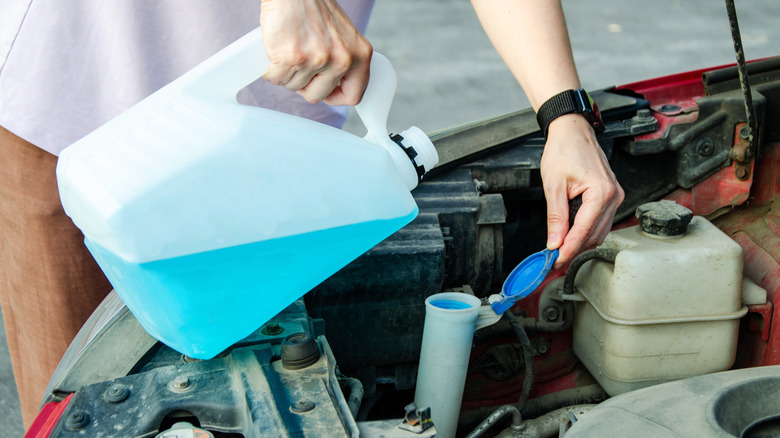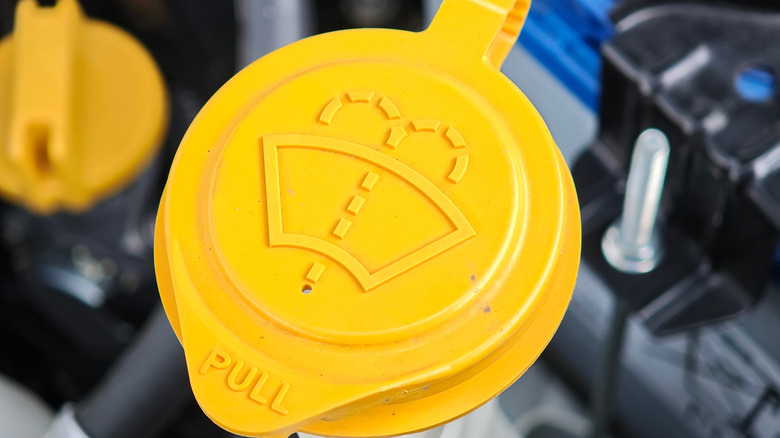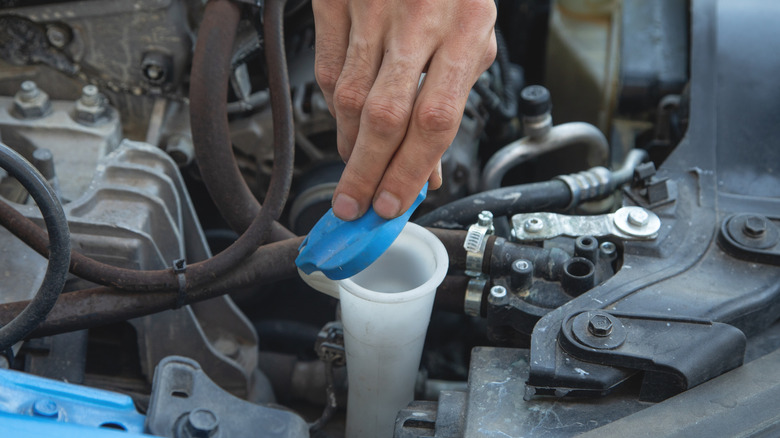How To Make Your Own Windshield Washer Fluid (And Why You Should)
Keeping a clean windshield is a safety necessity, whether you're dealing with bug residue in the summer or sludgy buildup in the winter. Windshield washer fluid is essential to this task. You might not think twice of spending $4 or $5 on a gallon of the blue stuff, but there is an alternative. Make washer fluid at home—you'll save money and avoid harsh chemicals in the process.
A gallon of DIY fluid uses roughly one cup of white vinegar (about $0.35) and one to two cups of 91% isopropyl alcohol (around $1.00 to $2.00 based on a quart-sized bottle), in addition to $1 for distilled water and a few pennies for liquid dish soap. That puts the total per-gallon cost at approximately $2.35 to $3.35 — potentially saving up to 40 percent on some commercial formulas.
Sure, store-bought fluid is convenient, but you're paying a premium for something that's mostly water, methanol, and color additives. Opt for name-brand washer fluid, and the retail price doubles. It's an unnecessary outlay when you likely have most of the ingredients already on hand. Another advantage of this windshield washer fluid DIY approach is that you can adjust the formula depending on the weather and driving conditions. This saves more money and further simplifies the process. All it takes is a few minutes to whip up a batch of washer fluid, and you can hit the road ready for whatever sticks to the windshield. Keep reading as we walk you through these simple steps.
How to make your own windshield washer fluid
Quality washer fluid doesn't depend on a secret formula, just a few simple ingredients: water, a cleaner, and an antifreeze solution (like alcohol) during winter months. There's nothing fancy or expensive involved. While water is a vital component, you want to avoid tap water. It contains minerals that can leave streaks or clog the car's spray nozzles. Ordinary water will work in a pinch, but don't make a habit of it. High-quality filtered water is an option, but distilled water is the best choice for most people. It's cheap, readily available, and comes in a plastic jug you can use for mixing the washer fluid.
Liquid dish soap handles the cleaning part, helping cut through road grime and bug debris. Add white vinegar to the mix to maximize the solution's effectiveness and reduce streaking. For climates where the temperatures go below freezing, you'll want to seasonally add isopropyl (rubbing) alcohol to prevent the fluid from freezing, which can damage plastic parts. Use at least a 91% isopropyl alcohol solution; 99% is even better. While you're mixing your own fluid, it's also a good time to inspect your wipers. Here's a quick guide on how to replace your car's windshield wipers.
When you're ready with all the ingredients, follow these steps:
- Pour off one cup of distilled water from the gallon jug (this can be poured into the washer reservoir or disposed of).
- Add one tablespoon of liquid dish soap to the remaining distilled water.
- Add one cup of white vinegar to the distilled water/dish soap.
- For Winter: Add one to two cups of isopropyl alcohol to the mix (two cups is better for extremely cold climates). You'll need to pour off additional distilled water to accommodate the alcohol. However, don't add the extra to the reservoir, as this will make the fluid more vulnerable to freezing.
- Thoroughly shake the container and pour the mixed fluid into the washer reservoir.
Any stored washer fluid should be labeled clearly. Isopropyl alcohol is toxic if swallowed, so keep it out of the reach of children and pets.
Why you should make your own windshield washer fluid
A few dollars of savings from mixing your own windshield washer fluid may seem insignificant, but it can add up if you use several gallons a year or maintain multiple vehicles. Buying larger quantities of the ingredients can lead to additional savings. However, keep in mind that isopropyl alcohol, for example, has a limited shelf life (usually up to three years, depending on the manufacturer). So, avoid overstocking supplies you won't use regularly.
Another advantage of DIY washer fluid is its environmental considerations. Most commercial washer fluids contain methanol, a form of alcohol used in automotive antifreeze and to make formaldehyde. Isopropyl alcohol is often used as a disinfectant; it's commonly found in hand sanitizers. While both substances are toxic, isopropyl alcohol is less so.
Putting a price tag on the other benefits is harder, including the satisfaction of doing something yourself. There's also the convenience of creating a customized washer fluid that meets your driving needs. Add alcohol in the winter or tweak how much dish soap and vinegar you use to combat road grime and bug residue. If you're customizing your fluid for freezing temperatures, you may also want to read how to safely defrost your car's windshield during winter.


